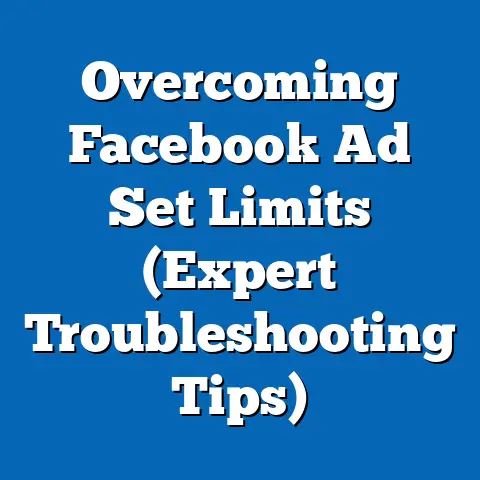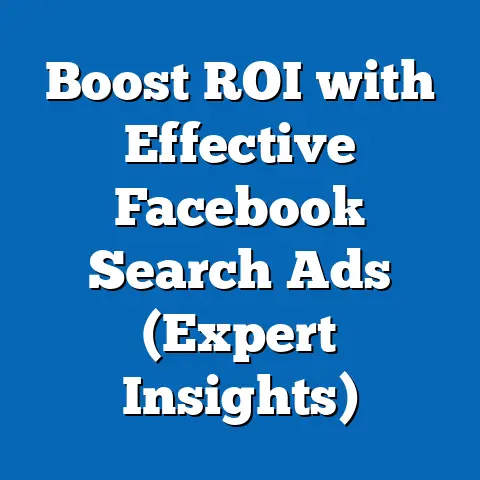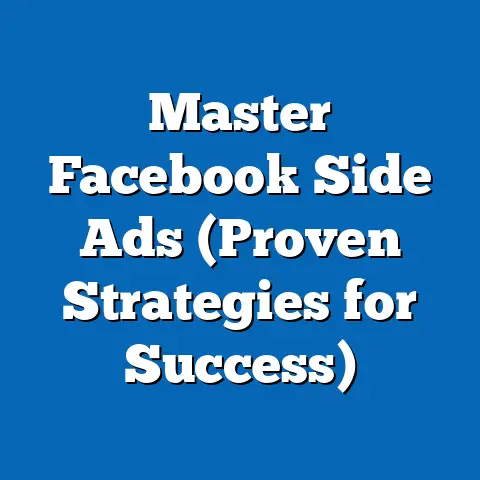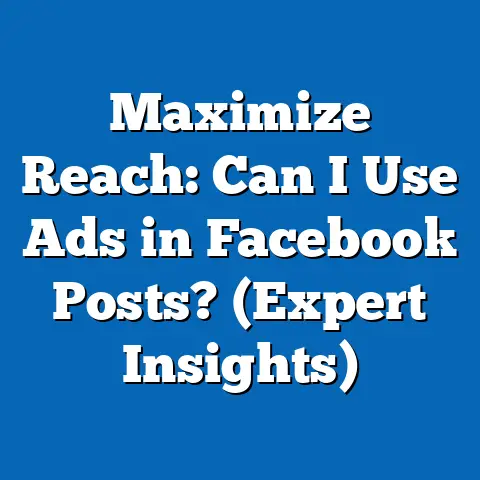Maximize fb ad Success with Best Interest Targeting (Smart Strategy)
What if you could transform your Facebook ad campaigns from a guessing game into a laser-focused operation? What if you could pinpoint your ideal customers on Facebook with such precision that your ad spend became a mere fraction of your revenue, and your ads were seen by those most likely to convert? It sounds like a dream, right? But with the right knowledge and strategy around interest targeting, it’s a very attainable reality.
In this article, I’m going to dive deep into the world of Facebook (now Meta) ad targeting, specifically focusing on the power of interest targeting. We’ll explore how to leverage this feature to reach the right audience, boost your ad performance, and ultimately, drive better results for your business. Let’s unlock the secrets to smarter, more effective Facebook advertising!
1. Understanding Facebook Ads and Interest Targeting
Let’s start with the basics. Facebook ads are a powerful tool for businesses of all sizes to reach a massive audience and achieve various marketing goals, from brand awareness to lead generation and sales. With billions of active users, Facebook provides an unparalleled platform for connecting with potential customers.
But simply running ads on Facebook isn’t enough. To see real results, you need to target the right people. That’s where interest targeting comes in.
What is Interest Targeting?
Interest targeting allows you to show your ads to people who have expressed an interest in specific topics, hobbies, activities, or brands on Facebook. This is based on the data Facebook collects from its users’ activity, including the pages they like, the posts they engage with, the groups they join, and the apps they use.
Think about it: when you like a page about hiking, join a group for coffee lovers, or use an app for learning a new language, you’re signaling your interests to Facebook. Advertisers can then leverage this information to target their ads to people with those specific interests.
Why is Interest Targeting Important?
In my experience, interest targeting is crucial for several reasons:
- Reaching the Right Audience: It allows you to connect with people who are genuinely interested in what you have to offer. This increases the chances of them engaging with your ads and ultimately converting into customers.
- Improving Ad Relevance: By showing your ads to a relevant audience, you can improve your ad’s relevance score. This leads to lower ad costs and better ad placement.
- Boosting Ad Performance: Targeting the right audience with relevant ads leads to higher click-through rates (CTR), conversion rates, and overall return on ad spend (ROAS).
- Reducing Wasted Ad Spend: Instead of showing your ads to a broad, unqualified audience, interest targeting allows you to focus your budget on people who are more likely to be interested in your product or service.
Takeaway: Facebook ads are a powerful tool, but their effectiveness hinges on targeting the right audience. Interest targeting is a key component of a successful Facebook ad strategy, allowing you to connect with people who are genuinely interested in your offerings and optimize your ad spend.
2. The Psychology Behind Interest Targeting
Beyond the technical aspects, understanding the psychology behind interest targeting can significantly enhance your ad campaigns. Why does targeting based on interests work so well? It boils down to a few key psychological principles:
Familiarity
People are naturally drawn to things that are familiar to them. When they see an ad related to their interests, it creates a sense of recognition and comfort. This familiarity can make them more receptive to your message.
Relevance
Ads that are relevant to a person’s interests are more likely to capture their attention. In a world of constant information overload, people tend to filter out anything that doesn’t seem immediately relevant to their needs or desires. Interest targeting ensures that your ads are seen by people who are likely to find them relevant.
Engagement
When people see ads that align with their interests, they’re more likely to engage with them. This could mean liking, commenting, sharing, or clicking on the ad. This engagement not only increases brand awareness but also provides valuable data for optimizing your campaigns.
Cognitive Consistency
People strive for consistency between their beliefs, attitudes, and behaviors. When your ads align with their expressed interests, it reinforces their existing beliefs and attitudes, making them more likely to take action.
Personal Anecdote: I once ran a campaign for a local bookstore targeting people interested in “reading,” “books,” and specific authors. The results were significantly better than a previous campaign that targeted a broader demographic. The ads resonated with the audience because they were directly aligned with their passions.
Takeaway: Understanding the psychology of familiarity, relevance, engagement, and cognitive consistency helps explain why interest targeting is so effective. By appealing to these psychological principles, you can create ads that resonate with your target audience and drive higher conversion rates.
3. Identifying Your Target Audience
Before you can start crafting your interest targeting strategy, you need to have a clear understanding of your target audience. This involves defining who they are, what their interests are, and what motivates them.
Step-by-Step Guide to Defining Your Target Audience
- Start with Your Existing Customers: Analyze your current customer base. What are their demographics (age, gender, location)? What are their interests and hobbies? What problems are they trying to solve with your product or service?
- Create Buyer Personas: Develop detailed buyer personas that represent your ideal customers. Give them names, backgrounds, and motivations. This will help you visualize your target audience and understand their needs.
- Research Audience Interests: Use tools like Facebook Audience Insights to research the interests of your target audience. This tool provides valuable data on demographics, interests, behaviors, and more.
- Conduct Competitor Analysis: Analyze your competitors’ target audience. Who are they targeting? What interests are they using? This can give you valuable insights into potential targeting options.
- Use Customer Surveys and Feedback: Collect feedback from your customers through surveys, interviews, or social media polls. Ask them about their interests, hobbies, and online behavior.
Tools and Methods for Researching Audience Interests
- Facebook Audience Insights: This is a free tool provided by Facebook that allows you to explore the demographics, interests, and behaviors of your target audience.
- Facebook Ad Library: Analyze your competitors’ ads to see what interests they are targeting.
- Google Analytics: If you have a website, use Google Analytics to track the interests and demographics of your website visitors.
- Social Media Listening Tools: Use social media listening tools to monitor conversations and trends related to your industry and target audience.
Example: Let’s say you’re selling organic skincare products. Your research might reveal that your target audience is primarily women aged 25-45 who are interested in “organic beauty,” “natural skincare,” “wellness,” and “sustainable living.”
Takeaway: Identifying your target audience is the foundation of a successful interest targeting strategy. By using a combination of research methods and tools, you can gain a deep understanding of your ideal customers and their interests.
4. Crafting Your Interest Targeting Strategy
Now that you have a clear understanding of your target audience, it’s time to craft your interest targeting strategy. This involves selecting the right interests for your campaigns and determining how to structure your targeting.
Selecting the Right Interests
- Relevance: Choose interests that are directly relevant to your product or service.
- Specificity: Consider the level of specificity. Do you want to target broad interests like “fitness” or more specific interests like “yoga for beginners”?
- Audience Size: Be mindful of the audience size. Targeting too narrowly can limit your reach, while targeting too broadly can dilute your results.
- Overlap: Avoid selecting interests that overlap too much. This can lead to ad fatigue and wasted ad spend.
Broad vs. Narrow Targeting
- Broad Targeting: This involves targeting a wide range of interests that are loosely related to your product or service. It’s useful for reaching a large audience and generating brand awareness.
- Narrow Targeting: This involves targeting a specific set of interests that are highly relevant to your product or service. It’s useful for reaching a highly qualified audience and driving conversions.
When to Use Each Approach:
- Broad Targeting: Use broad targeting when you’re launching a new product or service and want to reach a large audience.
- Narrow Targeting: Use narrow targeting when you have a specific target audience in mind and want to maximize conversions.
Examples of Effective Interest Combinations
- Fitness Apparel: Target people interested in “running,” “yoga,” “weightlifting,” and “activewear.”
- Coffee Subscription: Target people interested in “coffee,” “espresso,” “latte,” and “home brewing.”
- Travel Agency: Target people interested in “travel,” “adventure,” “luxury travel,” and specific destinations like “Paris” or “Rome.”
Personal Insight: Don’t be afraid to experiment with different interest combinations. I’ve often found that unexpected combinations can yield surprisingly good results. For example, targeting people interested in both “gardening” and “home decor” might be effective for a company selling outdoor furniture.
Takeaway: Crafting an effective interest targeting strategy involves selecting the right interests, considering the level of specificity, and balancing broad and narrow targeting. Experiment with different combinations to find what works best for your business.
5. Testing and Optimizing Your Interest Targeting
No matter how well you plan your interest targeting strategy, it’s essential to test and optimize it regularly. This involves A/B testing different interest groups, analyzing ad performance metrics, and refining your targeting based on the results.
The Importance of A/B Testing
A/B testing allows you to compare the performance of different interest groups and determine which ones are most effective. This involves creating multiple ad sets, each targeting a different set of interests, and then tracking their performance over time.
Analyzing Ad Performance Metrics
- Reach: The number of people who saw your ad.
- Impressions: The number of times your ad was displayed.
- Click-Through Rate (CTR): The percentage of people who clicked on your ad after seeing it.
- Conversion Rate: The percentage of people who completed a desired action (e.g., making a purchase, filling out a form) after clicking on your ad.
- Cost Per Click (CPC): The average cost you pay for each click on your ad.
- Cost Per Acquisition (CPA): The average cost you pay for each conversion.
- Return on Ad Spend (ROAS): The amount of revenue you generate for every dollar you spend on advertising.
Refining Your Interest Targeting Strategies
Based on your ad performance data, you can refine your interest targeting strategies in several ways:
- Eliminate Underperforming Interests: Remove interests that are not generating positive results.
- Expand Successful Interests: Add more interests that are similar to those that are performing well.
- Refine Your Audience: Narrow or broaden your audience based on your results.
- Adjust Your Bids: Increase or decrease your bids based on the performance of different interest groups.
Case Study: I worked with a client who was running a Facebook ad campaign for an online course. Initially, they were targeting a broad audience interested in “online learning.” After analyzing their ad performance data, we discovered that people interested in specific subjects, such as “digital marketing” and “web development,” were converting at a much higher rate. We refined their targeting to focus on these specific interests, and their conversion rate increased by 50%.
Takeaway: Testing and optimization are crucial for maximizing the effectiveness of your interest targeting strategy. By A/B testing different interest groups, analyzing ad performance metrics, and refining your targeting based on the results, you can continuously improve your ad performance.
6. Leveraging Advanced Targeting Techniques
Once you’ve mastered the basics of interest targeting, you can take your Facebook ad campaigns to the next level by leveraging advanced targeting techniques. These techniques allow you to reach even more qualified audiences and improve your ad performance.
Lookalike Audiences
Lookalike audiences allow you to reach people who are similar to your existing customers. This is based on the data Facebook collects from your customer list, website visitors, or app users.
How to Create a Lookalike Audience:
- Upload Your Customer List: Upload a list of your existing customers to Facebook.
- Create a Custom Audience: Create a custom audience based on your customer list.
- Create a Lookalike Audience: Create a lookalike audience based on your custom audience.
Custom Audiences
Custom audiences allow you to target people who have interacted with your business in some way, such as visiting your website, using your app, or engaging with your Facebook page.
Types of Custom Audiences:
- Website Visitors: Target people who have visited your website.
- App Users: Target people who have used your app.
- Customer List: Target people who are on your customer list.
- Engagement: Target people who have engaged with your Facebook page or ads.
Layering Interests
Layering interests involves combining multiple interests to create a more targeted audience. This can be useful for reaching a niche audience with specific needs or desires.
Example: If you’re selling vegan protein powder, you could layer the interests “veganism” and “fitness” to target people who are both vegan and interested in fitness.
Personal Experience: I’ve found that layering interests can be particularly effective for reaching a highly specific target audience. However, it’s important to be careful not to narrow your audience too much, as this can limit your reach.
Takeaway: Advanced targeting techniques like lookalike audiences, custom audiences, and layering interests can significantly enhance your Facebook ad campaigns. By leveraging these techniques, you can reach even more qualified audiences and improve your ad performance.
7. Real-World Success Stories
To illustrate the power of effective interest targeting, let’s look at some real-world success stories:
Case Study 1: E-Commerce Brand Increased ROAS by 300%
An e-commerce brand selling handmade jewelry was struggling to generate a positive return on ad spend. After analyzing their target audience and implementing a more focused interest targeting strategy, they were able to increase their ROAS by 300%.
Strategy:
- Identified their ideal customer as women aged 25-45 interested in “handmade jewelry,” “artisan crafts,” and “ethical fashion.”
- Created separate ad sets targeting each of these interests.
- A/B tested different ad creatives and copy to see what resonated best with each audience.
Results:
- ROAS increased by 300%.
- Conversion rate increased by 150%.
- Cost per acquisition decreased by 50%.
Case Study 2: Local Restaurant Increased Reservations by 200%
A local restaurant wanted to increase reservations and attract more customers. By implementing a targeted interest strategy, they were able to increase reservations by 200%.
Strategy:
- Targeted people living within a 5-mile radius of the restaurant who were interested in “food,” “restaurants,” and specific cuisines like “Italian” or “Mexican.”
- Created ads showcasing their menu items and highlighting their unique dining experience.
- Offered special promotions and discounts to encourage reservations.
Results:
- Reservations increased by 200%.
- Website traffic increased by 100%.
- Brand awareness increased significantly.
Key Takeaways from These Success Stories:
- Specificity is Key: The more specific you are with your interest targeting, the better your results will be.
- Relevance Matters: Ensure that your ads are relevant to the interests of your target audience.
- Testing and Optimization are Essential: Continuously test and optimize your targeting to improve your ad performance.
Takeaway: These real-world success stories demonstrate the power of effective interest targeting. By implementing a strategic approach and continuously optimizing your campaigns, you can achieve significant results for your business.
8. Common Pitfalls to Avoid
While interest targeting can be incredibly effective, there are also common pitfalls to avoid. Here are some mistakes that advertisers often make when using interest targeting:
Targeting Too Broadly
Targeting too broadly can dilute your results and waste your ad spend. It’s important to focus on interests that are highly relevant to your product or service.
Targeting Too Narrowly
Targeting too narrowly can limit your reach and prevent you from reaching potential customers. It’s important to strike a balance between specificity and reach.
Overlapping Interests
Selecting interests that overlap too much can lead to ad fatigue and wasted ad spend. Avoid selecting interests that are too similar.
Ignoring Other Targeting Options
Interest targeting is just one piece of the puzzle. Don’t ignore other targeting options like demographics, behaviors, and custom audiences.
Neglecting Testing and Optimization
Failing to test and optimize your interest targeting strategy can lead to poor results. It’s essential to continuously A/B test different interest groups and analyze your ad performance data.
My Biggest Mistake: In my early days of Facebook advertising, I made the mistake of assuming I knew my audience’s interests. I didn’t do enough research and ended up targeting a broad range of interests that weren’t actually relevant to my product. The results were disappointing, and I learned a valuable lesson about the importance of thorough research.
Takeaway: Avoiding these common pitfalls can help you maximize the effectiveness of your interest targeting strategy. By focusing on relevance, specificity, and continuous optimization, you can achieve better results for your Facebook ad campaigns.
Conclusion
Interest targeting is a powerful tool for maximizing your Facebook ad success. By understanding the psychology behind it, identifying your target audience, crafting an effective strategy, and continuously testing and optimizing your campaigns, you can reach the right people, improve your ad performance, and drive better results for your business.
Don’t just take my word for it. Try implementing these strategies in your own Facebook ad campaigns. Be strategic, be intentional, and watch your ad performance soar! The power of Facebook advertising lies in its ability to connect you with the right audience, and with the right interest targeting strategy, you can unlock that power and achieve your business goals. Now, go out there and make some magic happen!





